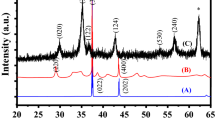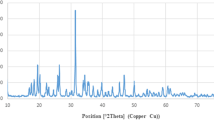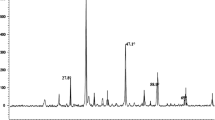Abstract
Metal nanomaterials such as bismuth oxide nanoparticles (Bi2O3NPs) have been extensively used in cosmetics, dental materials, pulp capping, and biomedical imaging. There is little knowledge about the health risk of Bi2O3NPs in humans, which warrants a thorough toxicity investigation of Bi2O3NPs at the cellular level. In this experiment, we investigated the cytotoxic effect of Bi2O3NPs on human breast cancer (MCF-7) cells over 24 and 48 h. MCF-7 cells were exposed to Bi2O3NPs at varying doses (0.1, 0.5, 1.0, 5, 10, 20, 40 μg/mL) for 24 and 48 h. We assessed the toxicity of Bi2O3NPs by measuring its effect on the viability and oxidative stress biomarkers, e.g., GSH, SOD, and catalase in MCF-7 cells. The pro-apoptotic effects of Bi2O3NPs on MCF-7 cells were determined via evaluating dysfunction of mitochondrial membrane potential (MMP), caspase-3 activity, externalization of phosphatidylserine, and chromosome condensation. Furthermore, apoptotic cells were evaluated using 7-AAD fluorescence stain and Annexin V-FITC. Bi2O3NPs induced oxidative stress in MCF-7 cells in a time- and dose-dependent manner. Bi2O3NPs increased the rate of both necrotic cells and apoptotic cells. In addition, the blue fluorescence of MCF-7 cells with condensed chromatin was increased in a time- and dose-dependent manner. In conclusion, the present study highlights the potential toxic effects of Bi2O3NPs at the cellular level and suggests further investigation of Bi2O3NPs before any medical purposes.








Similar content being viewed by others
Data availability
The data generated or analyzed in this article are online and publicly available without request.
References
Abudayyak M, Öztaş E, Arici M, Özhan G (2017) Investigation of the toxicity of bismuth oxide nanoparticles in various cell lines. Chemosphere 169:117–123
Alberts B (2008) The promise of cancer research. Science 320(5872):19. https://doi.org/10.1126/science.1158084
Bradford MM (1976) A rapid sensitive method for the quantification of microgram quantities of protein utilizing the principle of protein-dye binding. Anal Biochem 72:248–254
Chen C, Zhao KN, Masci PP, Lakhani SR, Antonsson A, Simpson PT, Vitetta L (2015) TGFβ isoforms and receptors mRNA expression in breast tumours: prognostic value and clinical implications. BMC Cancer 15:1010
Ding N, Yamashita U, Matsuoka H, Sugiura T, Tsukada J, Noguchi J, Yoshida Y (2011) Apoptosis induction through proteasome inhibitory activity of cucurbitacin D in human T-cell leukemia. Cancer 117(12):2735–2746
Doubeni C, Fedewa S, Levin T, Jensen C, Saia C, Zebrowski A, Quinn V, Rendle K, Zauber A, Becerra-Culqui T, Mehta S, Fletcher R, Schottinger J (2019) Modifiable failures in the colorectal cancer screening process and their association with risk of death. Gastroenterology 156(1):63–74
Finkel T, Holbrook NJ (2000) Oxidants, oxidative stress and the biology of ageing. Nature 408(6809):239–247
Gaetke LM, Chow CK (2003) Copper toxicity, oxidative stress, and antioxidant nutrients. Toxicology 189(1-2):147–163
He J, Li S, Shao W, Wang D, Chen M, Yin W, Wang W, Gu Y, Zhong B (2010) Activated carbon nanoparticles or methylene blue as tracer during video-assisted thoracic surgery for lung cancer can help pathologist find the detected lymph nodes. J Surg Oncol 102(6):676–682. https://doi.org/10.1002/jso.21684
Hüttemann M, Pecina P, Rainbolt M, Sanderson TH, Kagan VE, Samavati L, Lee I (2011) The multiple functions of cytochrome c and their regulation in life and death decisions of the mammalian cell: from respiration to apoptosis. Mitochondrion 11(3):369–381
Hyodo F, Chandramouli GV, Matsumoto S, Matsumoto K, Mitchell JB, Krishna MC, Munasinghe JP (2009) Estimation of tumor microvessel density by MRI using a blood pool contrast agent. Int J Oncol 35(4):797–804
Karam JA, Lotan Y, Karakiewicz PI, Ashfaq R, Sagalowsky AI, Roehrborn CG, Shariat SF (2007) Use of combined apoptosis biomarkers for prediction of bladder cancer recurrence and mortality after radical cystectomy. Lancet Oncol 8(2):128–136
Keunen E, Remans T, Bohler S, Vangronsveld J, Cuypers A (2011) Metal-induced oxidative stress and plant mitochondria. Int J Mol Sci 12(10):6894–6918
Kooti W, Servatyari K, Behzadifar M, Asadi-Samani M, Sadeghi F, Nouri B, Zare Marzouni H (2017) Effective medicinal plant in cancer treatment, part 2: review study. J Evid Based Complementary Altern Med 22(4):982–995
Novaro V, Roskelley CD, Bissell MJ (2003) Collagen-IV and laminin-1 regulate estrogen receptor α expression and function in mouse mammary epithelial cells. J Cell Sci 116(14):2975–2986
Patil D, Le TL, Bens KB, Alemozaffar M, Lay A, Pattaras J, Filson CP, Ogan K, Bilen MA, Master VA (2020) Dynamic evaluation of the modified Glasgow prognostic scale in patients with resected, localized clear cell renal cell carcinoma. Urology. S0090-4295(20)30340-X. https://doi.org/10.1016/j.urology.2020.03.024
Pradeepkumar T, and Kumar Pradeep (2018) Management of horticultural crops: Vol.11 Horticulture Science Series: In 2 Parts. New India Publishing. 601– 622
Riaz M, van Jaarsveld MT, Hollestelle A, Prager-van der Smissen WJ, Heine AA, Boersma AW, Smid M (2013) miRNA expression profiling of 51 human breast cancer cell lines reveals subtype and driver mutation-specific miRNAs. Breast Cancer Res 15(2):R33
Stewart E, Goshorn R, Bradley C, Griffiths LM, Benavente C, Twarog NR, Bahrami A (2014) Targeting the DNA repair pathway in Ewing sarcoma. Cell Rep 9(3):829–840
Strayer ME, Senftle TP, Winterstein JP, Vargas-Barbosa NM, Sharma R, Rioux RM, Janik MJ, Mallouk TE (2015) Charge transfer stabilization of late transition metal oxide nanoparticles on a layered niobate support. J Am Chem Soc 137(51):16216–16224. https://doi.org/10.1021/jacs.5b11230 Epub 2015 Dec 21
Toné S, Sugimoto K, Tanda K, Suda T, Uehira K, Kanouchi H, Samejima K, Minatogawa Y, Earnshaw WC (2007) Three distinct stages of apoptotic nuclear condensation revealed by time-lapse imaging, biochemical and electron microscopy analysis of cell-free apoptosis. Exp Cell Res 313(16):3635–3644
Valko M, Leibfritz D, Moncol J, Cronin MT, Mazur M, Telser J (2007) Free radicals and antioxidants in normal physiological functions and human disease. Int J Biochem Cell Biol 39(1):44–84
Wang C, Hu L, Poeppelmeier K, Stair PC, Marks L (2017) Nucleation and growth process of atomic layer deposition platinum nanoparticles on strontium titanate nanocuboids. Nanotechnology 28(18):185704
Xiong S, Mu T, Wang G, Jiang X (2014) Mitochondria-mediated apoptosis in mammals. Protein Cell 5(10):737–749
Funding
The authors extend their appreciation to the International Scientific Partnership Program (ISPP) at King Saud University for funding this research work through ISPP#009.
Author information
Authors and Affiliations
Contributions
Ali Alamer, Daoud Ali, Saud Alarifi, and Abdullah Alkahtane acquired and analyzed the data regarding the cytotoxicity of Bi2O3NPs. Mohammed AL-Zharani and Mohamed M. Abdel-Daim acquired and analyzed the data regarding physiochemical characterization of Bi2O3NPs and oxidative stress biomarkers. Gadah Albasher and Rafa Almeer acquired and analyzed the data regarding apoptotic markers. Abdulaziz Almalik and Ali H Alhasan contributed in writing the manuscript. Nouf K. Al-Sultan and Ali Alamer contributed in statistical analysis. Christos Stournaras, Saquib Hasnain, and Saad alkahtani were involved in the conception and design of the study and data interpretation, and critically revised the manuscript. All authors read and approved the final manuscript.
Corresponding author
Ethics declarations
Competing interests
The authors declare that they have no conflict of interest.
Ethics approval and consent to participate
Not applicable.
Consent to publish
Not applicable.
Additional information
Responsible editor: Philippe Garrigues
Publisher’s note
Springer Nature remains neutral with regard to jurisdictional claims in published maps and institutional affiliations.
Rights and permissions
About this article
Cite this article
Alamer, A., Ali, D., Alarifi, S. et al. Bismuth oxide nanoparticles induce oxidative stress and apoptosis in human breast cancer cells. Environ Sci Pollut Res 28, 7379–7389 (2021). https://doi.org/10.1007/s11356-020-10913-x
Received:
Accepted:
Published:
Issue Date:
DOI: https://doi.org/10.1007/s11356-020-10913-x




